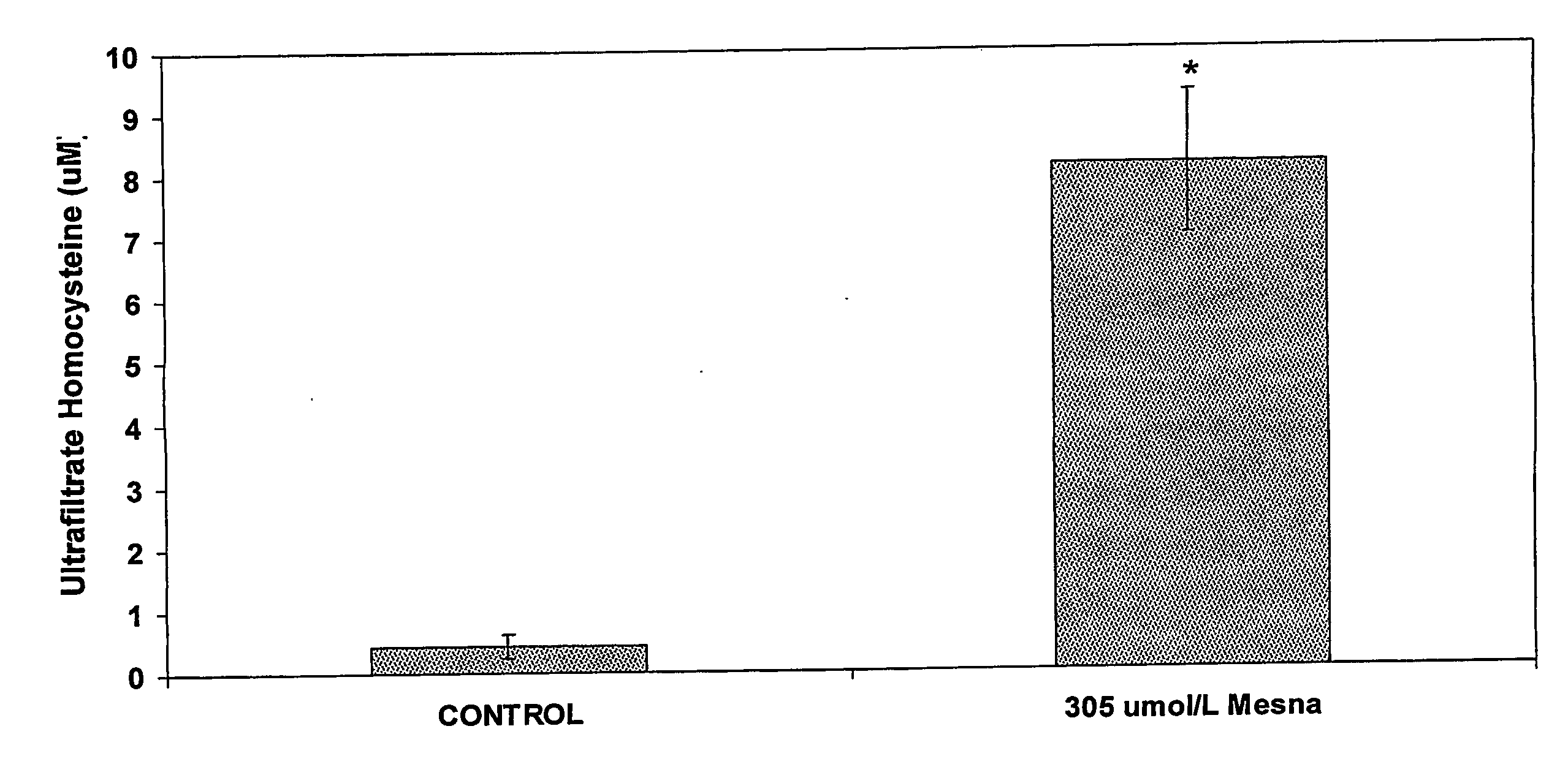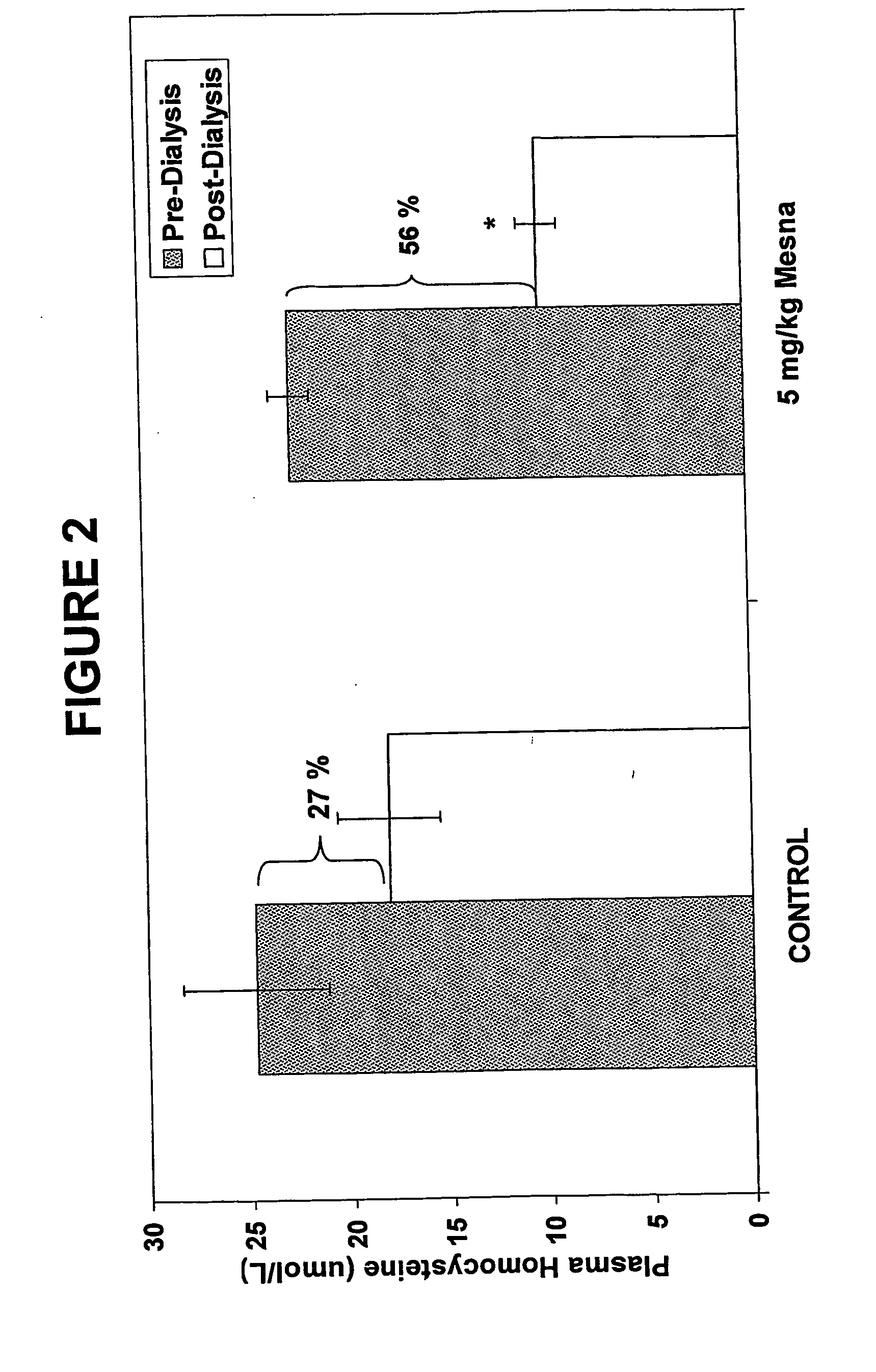Method of Treating Elevated Plasma Homocysteine Levels in Esrd Patients
a plasma homocysteine and esrd technology, applied in the field of elevated plasma homocysteine levels, can solve the problems of esrd patients who have been tested with limited success in lowering thcy, none of these interventions have been successful in normalizing plasma thcy in esrd, and the variety of lowering strategies have been tested in esrd patients with limited success, so as to reduce the amount of total plasma homocystein
- Summary
- Abstract
- Description
- Claims
- Application Information
AI Technical Summary
Benefits of technology
Problems solved by technology
Method used
Image
Examples
example 1
In Vitro Study
[0059] Mesna treatment caused a rapid change in the distribution of plasma Hcy from protein bound to free as evidenced by the amount measured in the ultrafiltrate. At time 0 (before addition of Mesna) only 0.5 μmol / L (1.7% of the total plasma Hcy) was in the free form. After only a 15 minute incubation with 305 μmol / L Mesna, 8.2 μmol / L (27.2% of the total) of Hcy was in the free dialyzable form. There was no change in the amount of free Hcy in the control sample at the end of the incubation (see FIG. 1).
example 2
In Vivo Study
[0060] All 3 patients had hyperhomocysteinemia (total plasma Hcy>15 μmol / L) and elevated plasma cysteine. The baseline pre-dialysis total plasma Hcy and cysteine on day 0 of the study were 24.4+ / −6.1 μmol / L and 358.6+ / −35.8 μmol / L respectively. All patient characteristics are shown in table 1.
[0061] Total plasma Hcy and cysteine both decreased post-dialysis (27% and 41% respectively) in the absence of Mesna treatment. Treatment with Mesna caused a significant decrease in the post-dialysis tHcy (p=0.035) and cysteine (p=0.009) as shown in FIGS. 2 and 3. Further, the Mesna effect was rapid and short-lived occurring during the first 30 minutes of dialysis (see FIGS. 4 and 5). The pre-dialysis tHcy on subsequent cycles remained lower in 2 patients (see FIG. 6, day 9). By the second cycle (day 12) pre-dialysis plasma Hcy had returned to baseline in all patients.
[0062] Mesna concentrations in plasma and UF (where applicable) were monitored throughout the test dialysis and...
example 3
Tolerability of Mesna
[0063] Two patients indicated they had a feeling of mild nausea. One patient's symptoms were present almost immediately after dosing and the other's symptoms did not present until ˜3.5 hours after dosing. Both patient's symptoms were rapidly (within 1 minute) reversed after administration of dimenhydrinate.
Discussion for Examples 1-3
[0064] All 3 patients with ESRD tested in this pilot study had hyperhomocysteinemia consistent with numerous literature reports21;22;23;24;25. Over 90% of patients with ESRD have elevated total plasma Hcy and the leading causes of death are cardiovascular related pathologies. The mechanism of Hcy accumulation in renal disease remains unknown and highly debated. For this reason treatment options for decreasing total plasma Hcy in ESRD are limited to supplementation with water soluble vitamins (folic acid, and vitamins B6 and B12) as well as daily or nocturnal hemodialysis29 and possibly variations in the dialysis membrane14. Vitam...
PUM
| Property | Measurement | Unit |
|---|---|---|
| volume | aaaaa | aaaaa |
| pKa | aaaaa | aaaaa |
| pKa | aaaaa | aaaaa |
Abstract
Description
Claims
Application Information
 Login to View More
Login to View More - R&D Engineer
- R&D Manager
- IP Professional
- Industry Leading Data Capabilities
- Powerful AI technology
- Patent DNA Extraction
Browse by: Latest US Patents, China's latest patents, Technical Efficacy Thesaurus, Application Domain, Technology Topic, Popular Technical Reports.
© 2024 PatSnap. All rights reserved.Legal|Privacy policy|Modern Slavery Act Transparency Statement|Sitemap|About US| Contact US: help@patsnap.com










